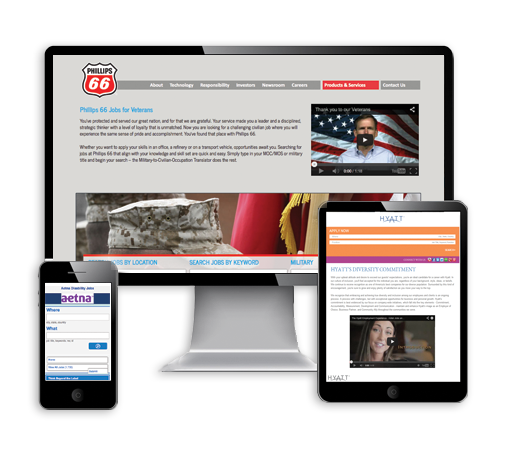How many times have you heard that recruiting is marketing? It’s an important concept for employers to try and understand if they want to remain competitive and attract the best candidates.
In last week’s blog post I mentioned that our marketing team recently attended the Mixwest Conference, an annual two-day event focused on marketing, social media, design and tech. Our team’s primary goal was to return with ideas on enhancing our marketing strategy for DirectEmployers, however much of what we learned is applicable to recruiting and attracting diverse candidates.
Several thought-provoking ideas for me came from a breakout session called 5 Technology Trends Disrupting Consumer Behavior, presented by ExactTarget’s Kyle Lacy. As Kyle shared his insight and perspective on consumers, I couldn’t help but think of how pertinent the information is when it comes to attracting job seekers and understanding their behavior. Here are the five trends he discussed:
1) Moments Matter. Lacy described a recent trip to Asia where he experienced a fully automatic toilet; he even provided us a picture in his PowerPoint. This toilet had a side panel with buttons for heat, music, light, fountains and a push button for the lid. Now that is creating a moment! So what’s a toilet have to do with job seekers? In recruiting we are usually facing extremely tight deadlines, which doesn’t allow opportunity to reflect on what kind of moment we are creating for our candidates. Have we streamlined the online apply process? Could we make it easier for job seekers to locate our jobs?
Lacy played an impactful YouTube video featuring an interview snippet from Conan O’Brien with Louis C.K. about how amazing everything is right now, but that nobody’s happy. Today’s advanced technology provides such great comfort that job seekers have become spoiled and have certain expectations about how easy it should be to apply for a job.
Starbucks understands how important moments can be for our veterans and military as these individuals face unique challenges returning to civilian work. Through their customized veteran/military focused career site, Starbucks provides search functionality for entering a military occupation code that will provide a list of corresponding civilian jobs within their organization. This customized solution makes it extremely easy for returning military to understand where their skills might fit within the civilian jobs available.
2.) Rise of Mobility. The iPhone and Android share the majority of the mobile market. According to Mary Meeker’s 2014 Internet Trends Report cited by Lacy, “Smartphone has a massive growth potential with currently only 30% of all mobile users.” Understanding the impact that mobile has on job seeker behavior is vital. Is your website responsive to mobile? Are your job seekers able to access your jobs via mobile? Can they apply via mobile? If not, you might be losing talent to your competitors.
According to ExactTarget’s 2014 Japan Consumer Insights Report, “…out of the 74% of Japanese consumers intending to upgrade their phone, 99.5% will be upgrading to a smartphone.” The world is getting smart when it comes to mobile – are you keeping up? Lacy also shared an interesting spin on a mobile app that has helped a Latin American company blow past their competitors.

3.) Personalization and Automation of Brand.
Return Path research shows that 41% of consumers buy more from brands that send personalized emails based on past buying behaviors. Lacy shared how Cover Girl has implemented a Virtual Makeup Studio to personalize their products. Consumers can upload their photo and virtually “try-on” makeup. This is creating a high conversion rate for repeat customers for Cover Girl.
Competing in today’s market can be daunting. How are you helping your employment brand stand out? Have you considered how important it is to attract diverse candidates? Are you personalizing your brand for these hard-to-find job seekers?
REI, the West Coast based outdoor retailer, has capitalized on personalizing their brand with an attractive career website, incorporating many of their own employees throughout the photos and content. Candidates can browse the many customized sites and get a true sense of what it is like to have a long-time career with their incredible company.
4.) Collaborative Economy. Lacy described the phases of Internet sharing as: A. Internet Era; B. Social Media Age; and C. Collaborative Economy Age. What is collaborative economy? It is an economy model where creation, ownership and access are shared between people and corporations. These are the same founding principles and 13 years of operating guidelines for DirectEmployers Association. Members of DirectEmployers are in good company with other collaborative economy companies like AirBNB, Uber, Feastly, TaskRabbit and Lending Club. Lacy explained that within a collaborative economy, the “crowd” is becoming like a company and bypasses inefficient organizations (like job boards). As a result, companies are resilient, connected, empowering others, efficient, and profitable.
5.) Connected Products. This includes technology like the Fitbit, Google Glass and miCoach by Adidas. There are even shoes developed for the blind/visually impaired with GPS technology to provide direction as well as independence. Lacy again referenced Mary Meeker’s 2014 Internet Trends Report and shared that sensors are rising rapidly at +34% year over year growth with 8 BILLION units shipped in 2013.
As technology evolves, so must our recruitment and branding. Understanding that consumers are job seekers, then making that connection between consumer behavior and job seeker behavior is important in helping you plan your future strategy.
Check out more examples of great brands that have embraced trending technologies on CaseStudy.jobs.
What other technologies have you seen trending? How has your company integrated it into your recruitment branding and processes? Please post your comment below!
